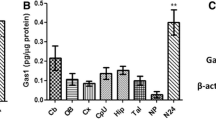Abstract
Insulin-like growth factor (IGF) I is a pleiotropic agent for the survival and differentiation of different types of nerve cells during development [1]. IGF-I over- expression in transgenic mice induces a marked increase in size and number of neurones in most cerebral areas [2]. The most thorough studies on IGF-I action within the context of brain are those performed in the last decade on cerebellar neuronal populations. In cerebellum, this somatomedin, its receptor and its specific binding proteins are developmentally expressed in such a fashion as to suggest a crucial role in circuit formation [3, 4]. Similar functions have been previously demonstrated or hypothesised for nerve growth factor (NGF) and other growth factors of the neurotrophin family. The action of neuronal growth factors may be exerted either via retrograde transport from target cells to the perikarion of the innervating neuron or, vice versa, via orthograde transport from the innervating neuron to the target cells [5]. The best characterized example of the former case is represented by NGF [6], while IGF-I displays the second type of trophic interaction with target cells [7].
Access this chapter
Tax calculation will be finalised at checkout
Purchases are for personal use only
Preview
Unable to display preview. Download preview PDF.
Similar content being viewed by others
References
Hepler JE, Lund PK (1990) Molecular biology of the insulin-like growth factors: relevance to nervous system function. Mol Neurobiol 4: 93–127
Carson MJ, Beheringer RR, Brinster RL, McMorris FA (1993) Insulin-like growth factor I increases brain growth and central nervous system myelination in transgenic mice. Neuron 10: 729–740
Zhang W, Lee W-H, Triarhou C (1996) Grafted cerebellar cells in a mouse model of hereditary ataxia express IGF-I system genes and partially restore behavioural function. Nat Med 2:65–71f trophic interaction with target cells [7].
Torres-Alemán I, Pons S, Arevalo MA (1994) The insulin-like growth factor I system in the rat cerebellum; developmental regulation and role in neuronal survival and differentiation. J Neurosci Res 39: 117–126
Korsching S (1993) The neurotrophic factor concept: a re-examination. J Neurosci 13: 2739–2748
Levi Montalcini R (1987) The nerve growth factor 37 years later. Science 237: 1154–1162
Nieto-Bona MP, Garcia-Segura LM, Torres-Alemán I (1993) Orthograde transport of insulin-like growth factor I from the inferior olive to the cerebellum. J Neurosci Res 36: 520–527
D’Mello SR, Galli C, Ciotti T, Calissano P (1993) Induction of apoptosis in cerebellar granule neurones by low potassium: inhibition of death by insulin-like growth factor 1 and cAMP. Proc Natl Acad Sci USA 90: 10989–10993
Galli C, Meucci O, Scorziello A, Werge TW, Calissano P, Schettini G (1995) Apoptosis in cerebellar granule cells is blocked by high KC1, forskolin and IGF-1 through distinct mechanisms of action: the involvement of intracellular calcium and RNA synthesis. J Neurosci 15: 1172–1179
Choi DW (1990) The role of glutamate neurotoxicity in hypoxic-ischemic neuronal death. Annu Rev Neurosci 13: 171–182
Calissano P, Ciotti MT, Battistini L, Zona C, Angelini A, Merlo D, Mercanti D (1993) Recombinant human insulin-like growth factor I exerts a trophic action and confers glutamate sensitivity on glutamate-resistant cerebellar granule cells. Proc Natl Acad Sci USA 90: 8752–8756
Zona C, Ciotti MT, Calissano P (1995) Human recombinant IGF-I induces the functional expression of AMPA/kainate receptors in cerebellar granule cells. Neurosci Lett 186: 75–78
Ciotti MT, Giannetti S, Mercanti D, Calissano P (1996) A glutamate-sensitising activity in conditioned media derived from rat cerebellar granule cells. Eur J Neurosci 8: 1591–1600
Dus L, Canu N, Zona C, Ciotti MT, Calissano P (1998) NMDA receptor modulation by a conditioned medium derived from rat cerebellar granule cells. Eur J Neurosci (in press)
Author information
Authors and Affiliations
Editor information
Editors and Affiliations
Rights and permissions
Copyright information
© 1998 Springer-Verlag Italia, Milano
About this chapter
Cite this chapter
Calissano, P. et al. (1998). The Role of IGF-I in Cerebellar Granule Cell Survival and Terminal Differentiation. In: Müller, E.E. (eds) IGFs in the Nervous System. Springer, Milano. https://doi.org/10.1007/978-88-470-2246-1_5
Download citation
DOI: https://doi.org/10.1007/978-88-470-2246-1_5
Publisher Name: Springer, Milano
Print ISBN: 978-3-540-75042-0
Online ISBN: 978-88-470-2246-1
eBook Packages: Springer Book Archive




